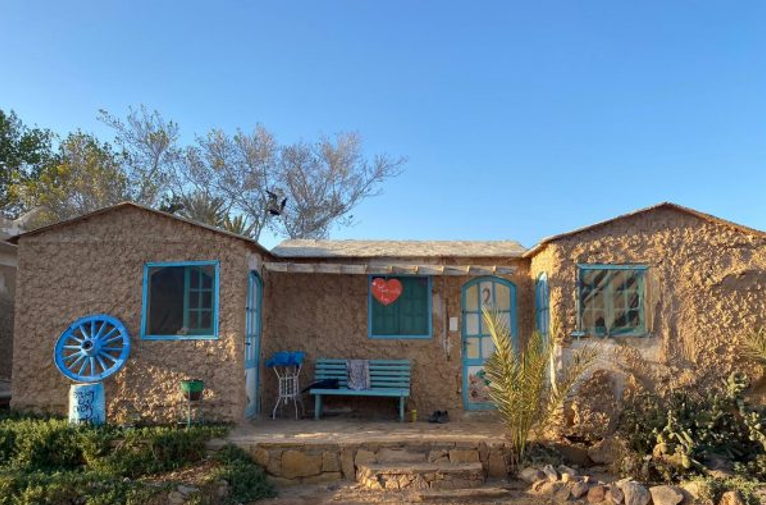Between the Gulf of Aqaba and the Sinai mountains, lies Habiba Organic Farm (HOF), a patch of green in a dry and arid plain.
Yousef parks his 4-wheel drive outside the gates of the farm and steps out into the cooling dusk. We follow him, welcoming the sea breeze and watching together as the heavy sun sinks behind the desert mountain range.

What the Site Looked Like Before Restoration
Yousef points toward the flat, low-lying lands before us, showing us what the site was like before his parents, Maged and Lorena, began farming in 2007. A pale grey rubble, embedded in sand, stretches from our feet far into the distance. A ramshackle hut made from scrap metal, frayed plastic and palm fronds provides shelter for a few goats. Sayal, the desert thorn tree, marks its place sporadically across the horizon. Here and there are baytheran, a small bush with grey, beaded leaves, used by the Bedouin for its medicinal properties.

What the Site Looks Like Now
To the right, Yousef points out a wide swathe of silt, no more than an arm’s depth, cutting its way down from the mountains towards the sea.
“In the past, we’d get a flash flood once or twice per year. Waters higher up would gather then travel down through the gullies, spilling out across the plains towards the sea. These waters carry important minerals, essential for the coral and other marine life. Some of that water would also sink down into the land, filling up wells and the larger aquifer. Now, with climate change, the rains are more erratic. Some years we have big floods. Other years it’s completely dry.”

With the hydrological cycle interrupted, groundwater has become less, and more salinated. On the coastal plains of South Sinai where average annual rainfall is 20mm or less, the future of agriculture hangs in the balance. Entering Habiba Farm though, these worries retreat for a moment. An avenue of date palms welcomes you, their fronds arching over a sandy track that leads past shade houses and mulched beds of young tomato and chili plants. After 3 months of searing, summer heat, the cool season has finally arrived. It’s time to plant! Around the farm, volunteers are preparing beds, pressing seedlings into the ground and renegotiating lines of black piping used for drip irrigation. Yousef shows us one of the wells that sources the farm. Water is pumped from the well into a holding tank and then gravity fed to the plants. With water being such a scarce and valuable resource, the irrigation regime is carefully timed and measured. Every drop counts.
In the height of harvest season, this small farm of 4 acres produces an abundance of food. Olive trees, palms, pomegranate and moringa provide shade for beds of salad greens, cucumber, eggplant, tomato, peppers, onions, asparagus and other vegetables. Quinoa is also grown onsite. Produce is destined first for the tables of those who grow the food and then for the broader community.

Food sovereignty is a priority. During the revolution of 2011, tourism crashed leaving local communities without revenue. The transport of food into the Sinai peninsula was also interrupted, further compounding people’s vulnerability. In this context, Maged felt compelled to scale up efforts at Habiba Farm. Rather than expand though, he began reaching out to his neighbours and other members of the community, encouraging and supporting them to embrace the methods of organic agriculture.
At the heart of Maged’s approach is the understanding that cooperation is crucial for survival. Now, in 2020, the network of producers he belongs to includes 75 farms across the Sinai. Maged and his team are working with scientists, research institutes and universities in Egypt and abroad, to study and document the impacts of human intervention, while also looking for solutions that can restore and rehabilitate the surrounding ecosystem.
Habiba Farm is also partnering with Ecosystem Restoration Camps and The Weather Makers in an ambitious plan to regreen and regenerate the entire Sinai peninsula. Through various water harvesting methods, the project aims to re-establish the natural hydrological cycle while also building top soil and developing regenerative agricultural enterprises that benefit the local community. “Food security, fresh water, jobs, and a sustainable future are the things we are working towards here”, said Maged. “With the right will and effort, these targets all lie within grasp”.

As the light fades, we walk to the edge of the fields where an earth-rendered, straw bale building sits with quiet majesty. A wooden porch juts out from the entrance door. A painted rainbow and orange sun decorates the front wall. This is Habiba’s Learning Centre, dedicated to the children of the village. Here they learn through direct contact with soil, plants and the cycle of seasons.
It’s here, in these places where awareness, ecology and action meet, that hope lies for our future!
_____
For more information, please email volunteer.habiba@gmail.com





